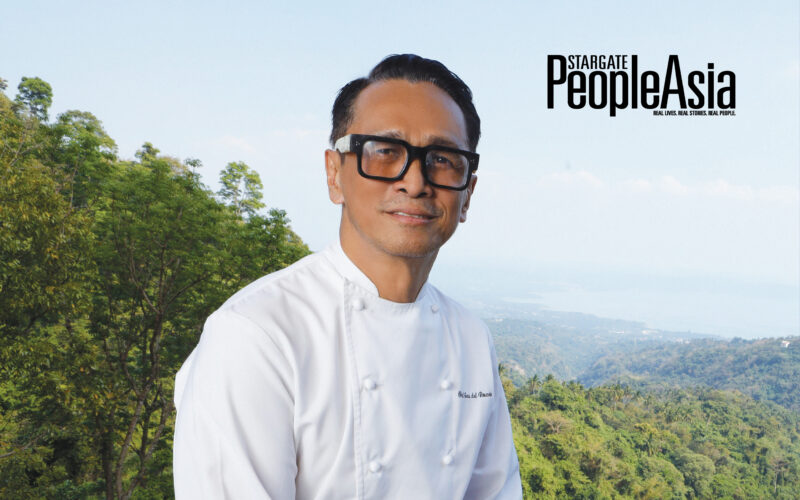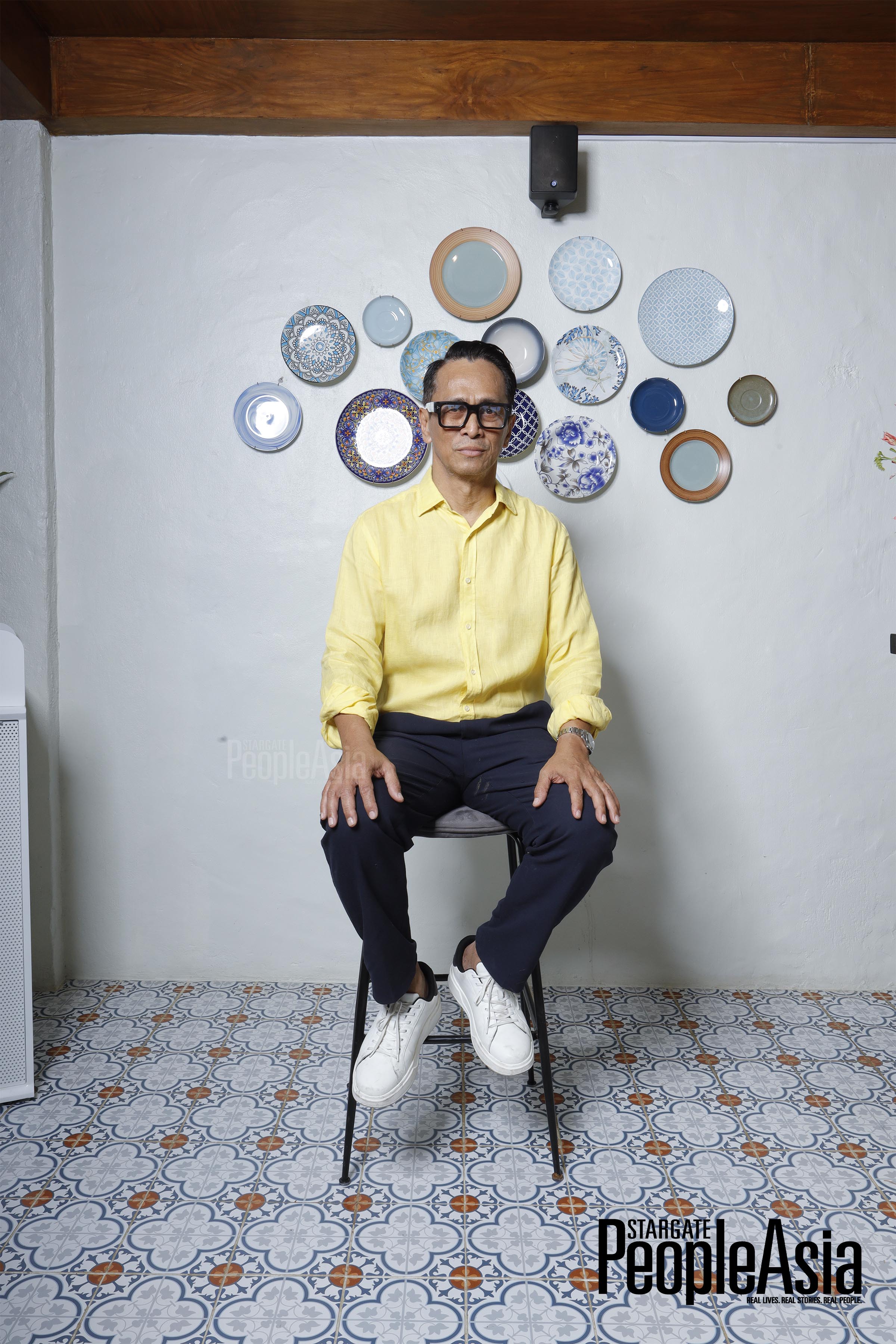Once dubbed as “Chef Rice” by some Western colleagues who made fun of his Asian roots in the kitchens of Paris, Chef Sau del Rosario has since risen to put Filipino food on the pedestal, one restaurant at a time.
By ALEX Y. VERGARA
Even before he set foot inside a restaurant’s kitchen, Chef Rosauro “Sau” del Rosario seemed destined to embark and thrive on a culinary career. Born and raised in Pampanga, a province celebrated for its long culinary tradition, to a family of accomplished cooks on both sides, the career path young Sau would most likely take someday seemed almost written in the stars.
Yet, as the seasoned chef behind such celebrated restaurants as 25 Seeds, Le Fleur, Sawsaw, Julyan (located either in Angeles City or in Poblacion, Makati) and the newly opened 180° by Chef Sau in Tagaytay shares with us today that he once tried to evade his date with destiny.
And talk about irony! The person who initially discouraged him, albeit indirectly, from becoming a chef was also the same person whom he considers today as his biggest influence and inspiration for becoming one — his late father, Chef Jesus del Rosario.
He first took up Economics before shifting to Hotel and Restaurant Administration at the University of the Philippines, Sau, who is turning 60 this October, shares with PeopleAsia. Apart from baking, say, brownies during elementary school to sell to his classmates and heading several cooking committees to comply with requirements in college, Sau had never once imagined himself making a career out of cooking.
From front to back of the house
Tall, slim and personable, Sau seemed cut out to start his career as a hotelier manning the front desk. And that was what he initially aimed for during his on-the-job training at one of Manila’s five-star hotels. But a funny thing happened every morning as he passed by the employees’ entrance on his way to his workstation.
“I also had to pass through the kitchen to get to the lobby, and every time the smell of something delicious was wafting through the air, I couldn’t resist from stopping by and taking a look,” he recalls.
During breaks, Sau would head back to the kitchen and, with his long sleeves rolled up to his elbows, start helping the staff either by rolling the dough or putting icing on the cupcakes.
“Suddenly, there was this awakening,” he says. “It was as if something I tried so hard to hide inside of me all those years came out. I experienced so much joy and wonder at the mere sight of, say, a croissant rising while being baked.”
As fate would have it, there was an opening in the kitchen, and the head chef asked him to apply. Sau, even before earning his HRA degree, eventually did and was accepted. And he never looked back, ditching a seemingly more glamorous career at the front of the house in favor of toiling silently at the back of the house. It also marked the start of his nearly 40-year journey to become one of the country’s leading chefs and exponents of authentic Filipino cooking, even once pushing for adobo with foie gras to be included in the menu of a French restaurant he worked for in Singapore.
“One day, out of the countless orders that came before, someone finally ordered adobo,” Sau recalls with a hearty chuckle. “When that happened, my fellow chefs all clapped their hands. And there I was beaming in a corner, almost teary-eyed. Instead of handing it over to a waiter, I brought out the dish myself.”
In all the times Sau did, he never once encountered a Filipino diner ordering adobo. On top of serving his prized dish, Sau would even regale guests who ordered it with stories of how the “Frenchified” Filipino dish came about. “That was why I had no problem shifting from Mediterranean cuisine, our original concept, to Filipino soon after we opened 180°,” he shares. And that was less than a month ago. During that short period of time, Sau often encountered such requests from diners as bulalo, kare-kare and fried tawilis.
Instead of scrapping the entire menu, Sau and his team tweaked it by retaining certain foreign dishes such as paella, callos and seafood pasta, among others, and serving them alongside the oft-requested Filipino favorites.
Angeles kid
Growing up in Angeles City, within the outskirts of the then Clark Air Base, Sau, or Ronnie to family and childhood friends, was one of eight children in the del Rosario household. His family, in turn, was one of countless Filipino families who depended on the American military facility for livelihood, as Sau’s father worked as one of several chefs there.
“My father worked for 42 years at Clark Air Base. Feeding members of the American Air Force was his first and last job,” Sau recalls with fondness. He would have probably worked there a bit longer if not for Mt. Pinatubo, which forced the Americans to abandon the base after it was buried overnight in ashfall from the volcano’s sudden eruption.
That forced the entire family to eventually immigrate to the US, a right Sau’s father had earned by virtue of his long years of service to the US Air Force. But that’s getting ahead of our story.
Still, with eight mouths to feed, Jesus, Sau’s dad, had very little time for himself or for his family during those earlier years. As Sau recalls it, his dad left for work at around 6 a.m. every day and wouldn’t be back until almost midnight. And he did that six days a week for 42 years almost without fail.
“During his day off, he would stay in his room and catch up on his sleep,” he says. He wasn’t a cold or indifferent father. He simply didn’t have a lot of spare time to spend with his family.
“Although I was already interested in cooking, I told myself then that I didn’t want to follow the career path my father took,” he says. “I wanted to have a life. That was until I discovered and embraced the fact years later that cooking is what I’m good at. It’s what I’m passionate about.”
But Sau barely learned anything from his father when it came to cooking. Instead, it was his mother, from the relatively famous Ocampo culinary clan of Pampanga, who taught the inquisitive boy the basics. Despite seldom seeing his father, Sau admired him for his work ethic and dedication to bring up his family. Sometime after college, he enrolled in a few short courses offered by the Culinary Institute of America.
When the del Rosario family was finally settled in the US in the mid 1990s, Sau, then already an HRA graduate and a young practicing chef, wanted to take his career several steps further by taking up culinary studies in France. He broached the idea to his folks who sadly had to turn him down because the family simply couldn’t afford it.
Sau understood. In the end, he was left with two choices: stay in the US and learn as best as he could from what was available to him there; or bite the bullet by leaving for France in the hopes of finding work there to finance his schooling. He couldn’t imagine himself carving out a culinary career in the US since he felt that the business environment there, instead of allowing him to flourish, would further stymie his imagination and creativity.
Manila, Paris, Shanghai, Singapore
But his stint in Paris had to wait, as Sau decided to return to the Philippines in the late 1990s to test the waters. He found himself working as the executive chef of Le Taxi, a newly opened hotel restaurant in Malate, then the center of the universe as far as Metro Manila’s gourmands and party habitues were concerned. That was also where this writer first met and interviewed Sau.
“I worked there for one and a half years, and I enjoyed it,” he says. “Still, I couldn’t shake of certain doubts I had about my talent and my abilities as a chef. Is this really the career for me? Is cooking really where I’m good at.”
That was when he decided to finally pack his bags, fly to Paris, and begin “my own Ratatouille story,” he says, referencing the Disney film. He was gone from the Manila scene for seven years, part of which were spent later as a chef in Shanghai and Singapore.
“In my desire to learn from all those Michelin-starred chefs in Paris, I had to pay my dues,” Sau continues. “I got sometimes bullied in the kitchen. Initially, nobody wanted to be friends with me because they probably dismissed me as just some Asian guy. For a time, they even called me ‘Chef Rice’ because I’m Asian.”
But Sau persevered and quietly did his job until he earned the respect of most of his colleagues. Looking back, he says, he harbors no ill feelings towards anyone. Everything that happened to him abroad, especially in Paris, toughened him, further reaffirming his love for cooking and the desire to push Filipino food on the global stage.
“My years abroad gave me the confidence and the credentials to finally call myself a chef,” says Sau. “Despite having earned that title though, the pressure is always on.”
Sau was happy living the life of an expat until he received a call from restaurateur Annabel Wisniewski enticing him to come back home where “a big project” awaited him. That project turned out to be the now-defunct M Café.
“I wasn’t really too keen on returning anytime soon,” he admits. “I was enjoying my life abroad. But I also knew that I belonged here. I gave myself six months. If it didn’t work, then I’d leave Manila and find work elsewhere.”
Six months turned into one year, and one year turned into almost two decades. And with that time came several other projects that further honed him as a chef. It was only much later when Sau realized the need for him to put up his own restaurants where he not only has total control but is also free from the usual complications of running a business with partners. Of the five restaurants he runs today, Sau wholly owns four except for 180°.
Asked what he thinks is stopping Filipino food from being the next hottest thing on the global table, Sau says it has very little to do with presentation and the fact that local dishes aren’t meant to be served degustation-style like, say, Japanese, Korean and even Vietnamese food. He appreciates all the promotions done by both private and public sectors to train the spotlight on Filipino food, but the problem, he says, is often traced to Filipinos themselves.
Quoting the celebrated French chef Alain Ducasse, also a proud recipient of several Michelin stars, whom Sau had the privilege of working with in Paris, he says, “Before we could even begin trying to entice foreigners to try our food, Ducasse said that we Filipinos must be proud of our food first.”
And with that pride comes the knowledge of knowing what real, honest-to-goodness Filipino food is. Sorry, in Chef Sau del Rosario’s book, American-inspired Filipino fast food, including burgers and fried chicken that are supposedly bringing so much joy to homesick Filipinos and their foreign friends abroad, doesn’t count.
Photography by DIX PEREZ
Art direction by DEXTER FRANCIS DE VERA
Shot on location at 180° by Chef Sau in Tagaytay






